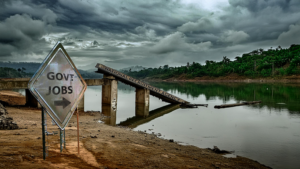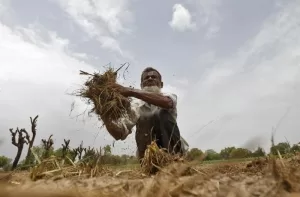On 21 April, during a high-level committee meeting on the rejuvenation of the Yamuna river, VK Saxena made a plea to his city: New Delhi must ramp up its treatment of wastewater. As lieutenant governor of New Delhi, which also makes him the national capital region’s constitutional head, Saxena described how the city currently generates 2,907 million litres of sewage each day. Of this, 75% is treated, a figure that prompted Saxena to call for 95% by the end of June. Officially, there is no confirmation on whether these targets have been achieved; unofficially, The Third Pole understands that although much of the construction is complete, the final phase has been interrupted by monsoon rains.
The committee for the rejuvenation of the Yamuna was set up on the orders of India’s lead environmental court, the National Green Tribunal, after it was petitioned to deal with the continued failure of governmental authorities to clean up the river. Less than 2% of India’s fourth-longest river flows through Delhi, but about 80% of the Yamuna’s pollution enters during this 22-kilometre stretch. The sewage flowing from Delhi into the river is a mix of wastewater generated from households, commercial establishments and industry. As such, this untreated effluent carries disease-causing toxins with it, all of which is dumped into the Yamuna.
To restore the Yamuna, about 101.79 million USD (8.44 billion INR) was spent on expanding Delhi’s sewage treatment infrastructure between April 2016 and March 2021. But of the eight river water samples taken by the Delhi Pollution Control Committee during routine testing in April, seven were not fit for drinking nor bathing.
Furthermore, at four sampling points biochemical oxygen demand (BOD) [1] levels had actually deteriorated since 2016. This is despite the rollout of a Yamuna river revival programme, which included two government-led campaigns: Namami Ganga, launched in 2014, was a Ganga river cleanup and conservation initiative that allocated some of its funding to the Yamuna; India’s National Green Tribunal followed up in 2018, with an order for Delhi’s government to restore polluted stretches of the Yamuna.
Water-stressed India relying on depleting groundwater
Delhi’s sewage challenge mirrors water challenges across India, which is one of the most water-stressed countries in the world. Without an effective strategy to treat and reuse wastewater, more than one billion people are becoming increasingly dependent on India’s rapidly depleting groundwater supplies for their domestic, agricultural and industrial needs. This dependency is high in north India, including Delhi, which has been singled out as a global groundwater depletion hotspot in a new study by Indian Institute of Technology Gandhinagar (IITG) scientists.
According to the IITG’s study, India’s projected 2021-2040 rainfall will, at best, only recover about half of the total groundwater that was removed by the country between 2002 and 2020.
Another analysis by the Council on Energy, Environment and Water (CEEW) shows that, by 2025, 11 of India’s 15 major river basins are expected to experience water stress.
Who is responsible for India’s dysfunctional sewage treatment?
In India, sewage is either treated at its source, or centrally in large municipal plants. To enable the reuse of treated wastewater, in 2006 the central government mandated that every building over a certain size must install a sewage treatment plant and the requisite plumbing.
Ananth Kodavasal, director of the engineering consultancy Ecotech, says that an estimated eight in 10 private sector treatment plants don’t perform optimally: “We consider a plant a failure even if it treats a part of the sewage and discharges the rest untreated.” Rohini Pradeep, wastewater management lead at the sanitation-focused not-for-profit CDD India, says this could be down to “the experience and preference of the building’s architects, mechanical, engineering, plumbing contractors, and other contractors [whose] selection may not necessarily be the best option for the user in terms of performance and costs”.
The story is hardly better in the public sector, where much of the installed treatment capacity does not meet the prescribed standards of pollution control boards. For instance, in Delhi, only 29% of installed capacity was compliant as of February this year.
The benefits of treating and using wastewater
When it comes to sewage, India produces 72,368 million litres per day (mld). Of that, only 20,235mld (28%) is treated and just 6% is actually reused.
“Availability of treated and used water could be increased by developing low-cost, fit-for-purpose methods to treat sewage generated in rural India.” That’s according to Ravinder Kaur, a principal scientist at the Indian Agricultural Research Institute.
Furthermore, a CEEW study from March states that, because treated water is nutrient-rich, if it is used in agriculture it can reduce fertiliser bills by up to 10%. The study also highlights the fact that pumping less groundwater for irrigation would also reduce energy consumption and therefore greenhouse gases emissions.
Additionally, the CEEW study finds that operators of sewage treatment plants could sell their water to farms and other industry at more or less the standard market price for treated wastewater. In 2021, that figure was 20 INR (0.24 USD) per kilolitre (kl).
The treatment of wastewater, however, has not been one of India’s infrastructure priorities until fairly recently. According to a new national framework on the safe reuse of treated water, one reason for this may be that the collection and treatment of used water has historically been seen “as part of a ‘linear’ process”, as opposed to one of the “components of a wider circular economy”.
Putting groundwater use in perspective
The snag is, the cost of fresh water is so heavily subsidised in India, and groundwater pumping so poorly monitored, that consumers have no incentive to buy treated wastewater. Therefore, the private sector doesn’t consider sewage treatment a viable business.
Bengaluru is India’s second-largest city by area, where Kodavasal estimates that it costs the water authority roughly 1 USD (80-90 INR) to transport 1kl of fresh water about 100km, from the Cauvery River. On the outskirts of the city, where supply pipelines haven’t been laid, the water authority instead supplies water through tankers at a cost of 1.30 USD (100-120 INR) per kilolitre. Yet despite these costs, the utility only charges domestic users between 0.01 and 0.55 USD (7-45 INR) per kilolitre.
These figures are significantly higher than those for recycled water. Kodavasal estimates that used water treated in a large plant – with a capacity of 1,000,000kl per day – costs 0.2 USD (15-18 INR) per kilolitre. Water treated in a smaller plant – say, 100,000kl per day – costs 0.38 USD (30-35 INR) per kilolitre.
The CEEW’s senior programme lead, Nitin Bassi, sums it up: “If fresh water were priced to reflect its scarcity value, especially in areas with water stress, the demand for treated wastewater – the less expensive alternative – would increase.”
Kodavasal agrees: “People would realise that a large sewage treatment plant is a gold mine; the cheapest source of water you can be sure of.”
So far, the only major Indian city where this has happened is Chennai, which faced a major water crisis in the summer of 2019. In response to the crisis, Chennai’s urban water authority has since developed an effective business model to treat and reuse water. The question is, will every other major city in India have to face such a crisis before it learns to reuse this precious resource?
Notes
1. Biochemical oxygen demand: Discharging untreated sewage into groundwater, lakes and rivers introduces a host of contaminating pathogens into freshwater sources. The biochemical oxygen demand (BOD) is the amount of dissolved oxygen that aerobic bacteria need to decompose the organic waste in water. High BOD levels indicate high oxygen demand from the water’s bacteria, therefore indicating high levels of organic pollutants.
(Charu Bahri is an India-based journalist, who writes on health, the environment, society and industry. Courtesy: The India Forum, an independent online journal-magazine that seeks to widen and deepen our conversations on the issues that concern people.)




